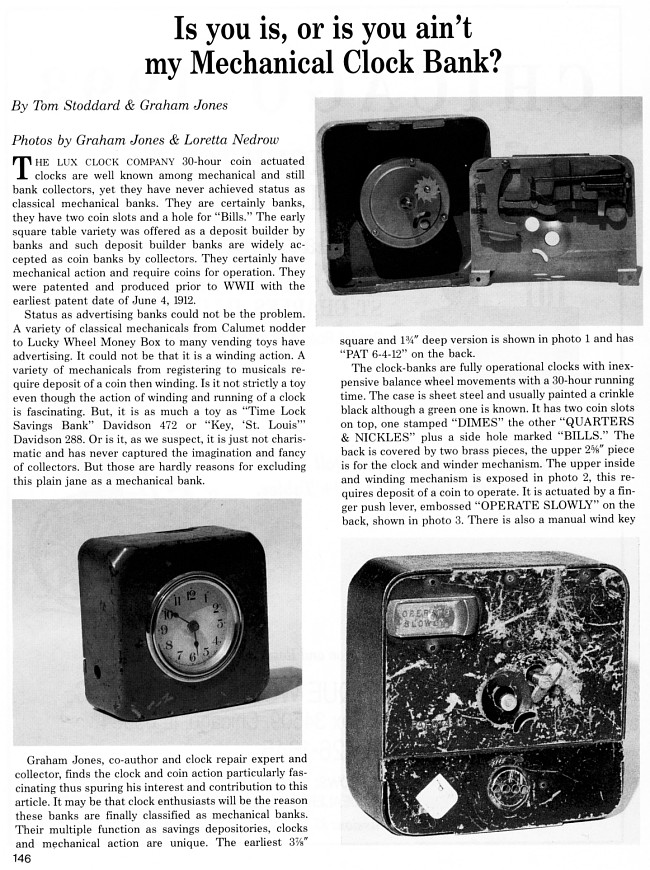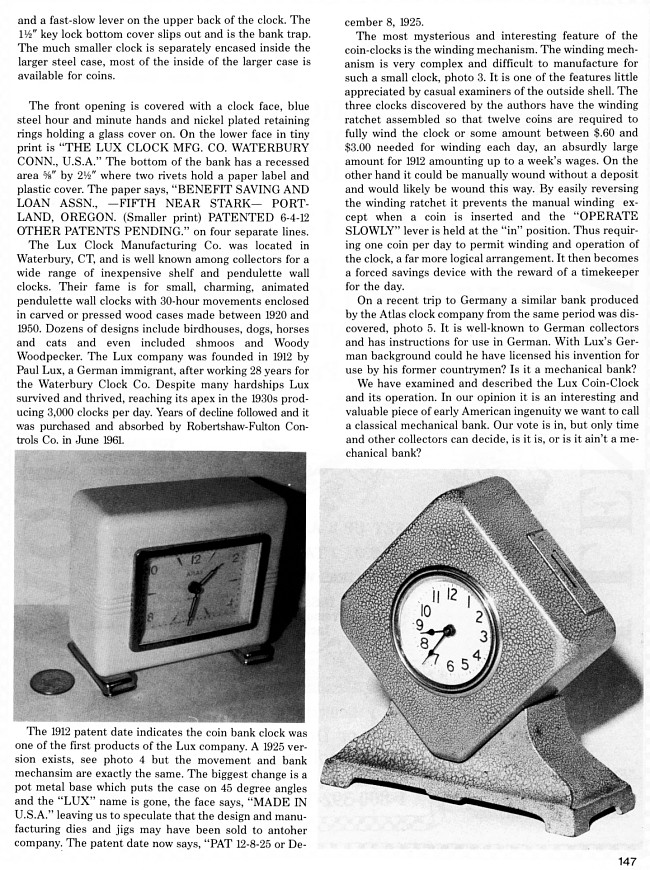|
1993
Is you is, or is you ain't
my Mechanical Clock Bank?
By
Tom Stoddard & Graham Jones
Photos by Graham Jones & Loretta Nedrow
THE LUX CLOCK COMPANY 30-hour coin actuated clocks are well known
among mechanical and still bank collectors, yet they have never achieved
status as classical mechanical banks. They are certainly banks, they
have two coin slots and a hole for "Bills." The early square table
variety was offered as a deposit builder by banks and such deposit
builder banks are widely accepted as coin banks by collectors. They
certainly have mechanical action and require coins for operation. They
were patented and produced prior to WWII with the earliest patent date
of
June 4, 1912.
Status as advertising banks could not be the problem. A variety of
classical mechanicals from Calumet nodder to Lucky Wheel Money Box to
many vending toys have advertising. It could not be that it is a winding
action. A variety of mechanicals from registering to musicals require
deposit of a coin then winding. Is it not strictly a toy even though the
action of winding and running of a clock is fascinating. But, it is as
much a toy as "Time Lock Savings Bank" Davidson 472 or "Key, 'St.
Louis'" Davidson 288. Or is it, as we suspect, it is just not
charismatic and has never captured the imagination and fancy of
collectors. But those are hardly reasons for excluding this plain jane
as a mechanical bank.
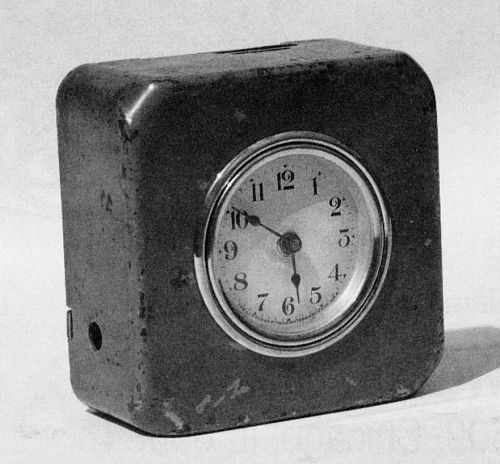
Graham Jones, co-author and clock repair expert and collector, finds the
clock and coin action particularly fascinating thus spurring his
interest and contribution to this article. It may be that clock
enthusiasts will be the reason these banks are finally classified as
mechanical banks. Their multiple function as savings depositories,
clocks and mechanical action are unique. The earliest 3-7/8" square and
1-3/4" deep version is shown in photo 1 and has "Pat
6-4-12" on the back.
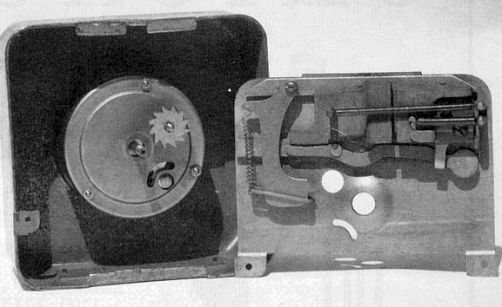
The
clock-banks are fully operational clocks with inexpensive balance wheel
movements with a 30-hour running time. The case is sheet steel and
usually painted a crinkle black although a green one is known. It has
two coin slots on top, one stamped "DIMES" the other "QUARTERS &
NICKELS" plus a side hole marked "BILLS." The back is covered by two
brass pieces, the upper 2-5/8" piece is for the clock and winder
mechanism. The upper inside and winding mechanism is exposed in photo 2,
this requires deposit of a coin to operate. It is actuated by a finger
push lever, embossed "OPERATE SLOWLY" on the back, shown in photo 3.
There is also a manual wind key and a fast-slow lever on the upper back
of the clock. The 1/2" key lock bottom cover slips out and is the bank
trap. The much smaller clock is separately encased inside the larger
steel case, most of the inside of the larger case is available for
coins.
The front opening is covered with a clock face, blue steel hour and
minute hands and nickel plated retaining rings holding a glass cover on.
On the lower face in tiny print is "THE LUX CLOCK MFG. CO. WATERBURY
CONN., U.S.A." The bottom of the bank has a recessed area 5/8" by 2-1/2"
where two rivets hold a paper label and plastic cover. The paper says,
"BENEFIT SAVING AND LOAN ASSN., —FIFTH NEAR STARK— PORTLAND, OREGON.
(Smaller print) PATENTED
6-4-12 OTHER PATENTS PENDING." on four separate lines.
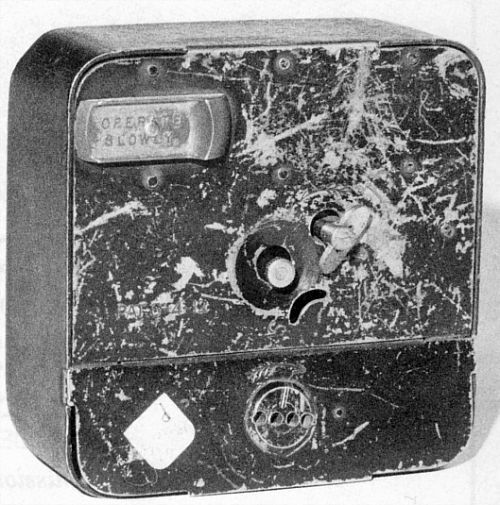
The
Lux Clock Manufacturing Co. was located in Waterbury, CT, and is well
known among collectors for a wide range of inexpensive shelf and
pendulette wall clocks. Their fame is for small, charming, animated
pendulette wall clocks with 30-hour movements enclosed in carved or
pressed wood cases made between 1920 and 1950. Dozens of designs include
birdhouses, dogs, horses and cats and even included shmoos and Woody
Woodpecker. The Lux company was founded in 1912 by Paul Lux, a German
immigrant, after working 28 years for the Waterbury Clock Co. Despite
many hardships Lux survived and thrived, reaching its apex in the 1930s
producing 3,000 clocks per day. Years of decline followed and it was
purchased and absorbed by Robertshaw-Fulton Controls Co. in June 1961.
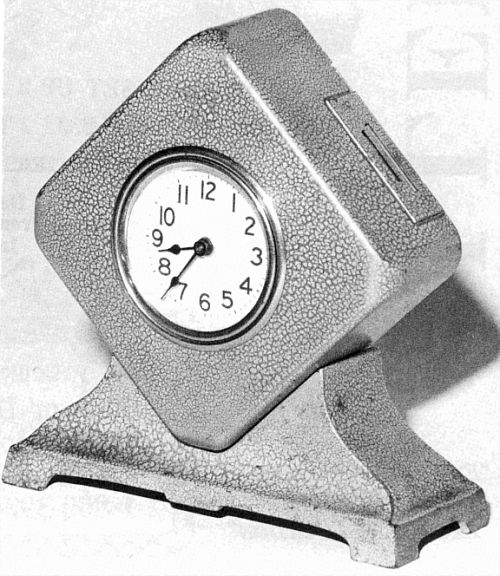
The
1912 patent date indicates the coin bank clock was one of the first
products of the Lux company. A 1925 version exists, see photo 4 but the
movement and bank mechanism are exactly the same. The biggest change is
a pot metal base which puts the case on 45 degree angles and the "LUX"
name is gone, the face says, "MADE IN U.S.A." leaving us to speculate
that the design and manufacturing dies and jigs may have been sold to
another company. The patent date now says, "PAT
12-8-25" or
December 8, 1925.
The most mysterious and interesting feature of the coin-clocks is
the winding mechanism. The winding mechanism is very complex and
difficult to manufacture for such a small clock, photo 3. It is one of
the features little appreciated by casual examiners of the outside
shell. The three clocks discovered by the authors have the winding
ratchet assembled so that twelve coins are required to fully wind the
clock or some amount between $.60 and $3.00 needed for winding each day,
an absurdly large amount for 1912 amounting up to a week's wages. On the
other hand it could be manually wound without a deposit and would likely
be wound this way. By easily reversing the winding ratchet it prevents
the manual winding except when a coin is inserted and the "OPERATE
SLOWLY" lever is held at the "in" position. Thus requiring one coin per
day to permit winding and operation of the clock, a far more logical
arrangement. It then becomes a forced savings device with the reward of
a timekeeper for the day.
On a recent trip to Germany a similar bank produced by the Atlas
clock company from the same period was discovered, photo 5. It is
well-known to German collectors and has instructions for use in German.
With Lux's German background could he have licensed his invention for
use by his former countrymen? Is it a mechanical bank?
We have examined and described the Lux Coin-Clock and its
operation. In our opinion it is an interesting and valuable piece of
early American ingenuity we want to call a classical mechanical bank.
Our vote is in, but only time and other collectors can decide, is it is,
or is it ain't a mechanical bank?
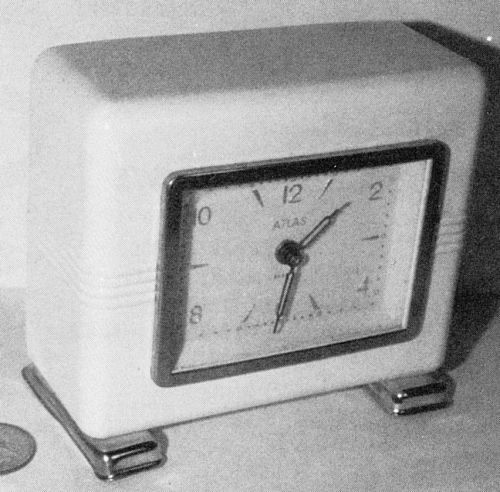
|
Web note:
Patent #
1,028,232 issued on June 4, 1912 (as listed on the Lux Clock Bank)
was issued to Jasper E. Lewis of Philadelphia and covered
coin-controlled circuit-closing apparatus, coin-in-slot for actuating
apparatus for motors adapted to drive fans, etc. for a predetermined
length of time.
Patent #
1,029,305 issued on June 11, 1912 to Paul Lux of Waterbury,
Connecticut covered an alarm clock mechanism and was assigned to the
Waterbury Clock Company when issued.
Patent #
1,564,431 issued on December 8, 1925 to Charles and Nicholas Malouf of
Chicago, Illinois covered a coin-controlled clock with drawings as with
the Lux Clock shown in this article.
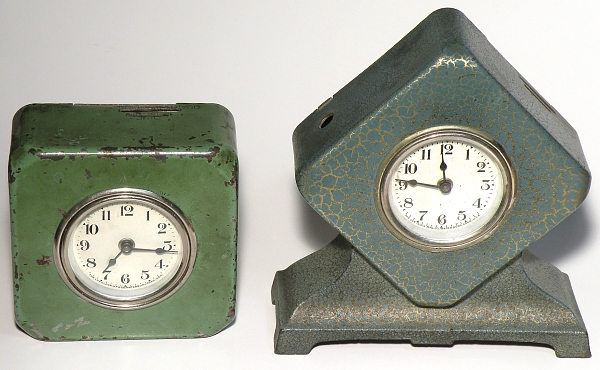
Patent number research and banks in
photo above from the collection of Bill & Wendy Jones.
|
